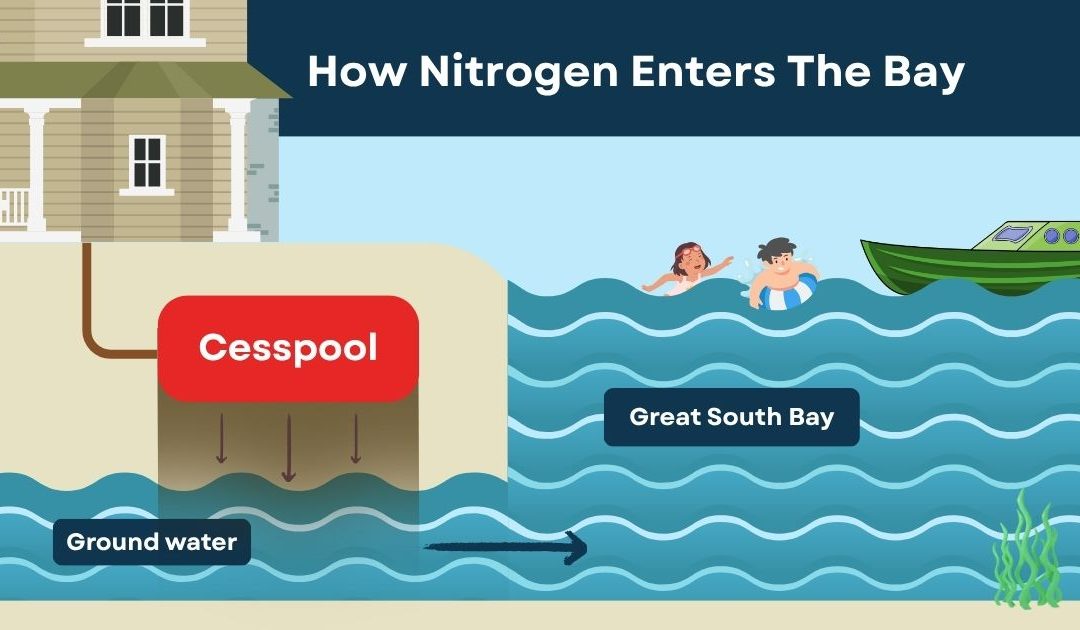Long Island’s South Shore — with its working waterfronts, salt marshes, and scenic bays — is under threat. The culprit? Nitrogen pollution. Fueled by outdated septic systems and cesspools, this pollution degrades water quality, fuels harmful algal blooms, and disrupts marine ecosystems in places like the Great South Bay.
To turn the tide, Suffolk County is investing in a multi-pronged solution: sewer expansion, decentralized wastewater treatment systems, and innovative/alternative (I/A) onsite systems — all designed to reduce nitrogen and protect both residential and commercial areas.
The Problem with Septic Systems
Most homes and businesses on the South Shore are not connected to sewers. Instead, they rely on cesspools or traditional septic systems that were never designed to treat nitrogen. Wastewater from these systems seeps into the ground and migrates to nearby creeks, rivers, and the bay — bringing nitrogen along with it.
This nitrogen overload feeds algae, which blooms rapidly, depleting oxygen and creating “dead zones” in the water. Eelgrass beds disappear, fish and shellfish die off, and the ecological and economic health of our bays is jeopardized.
The Forge River Watershed Sewer Project
One of the most impactful projects to date is the Forge River Watershed Sewer Project in Mastic. With more than $224 million in funding from state, county, and federal sources, this initiative replaces over 1,800 individual septic systems with a centralized sewer system that connects to a new, advanced wastewater treatment plant.
The result? A projected 70% reduction in nitrogen flowing into the Forge River, one of the region’s most impaired waterways. This project demonstrates the dramatic environmental benefit of modern, well-planned sewer infrastructure in a densely populated, low-lying coastal area.
Mastic Beach: Recharge Over Discharge
Just next door, Mastic Beach is launching its own sewer district to serve the downtown corridor along Neighborhood Road. With funding from the American Rescue Plan, the project includes a new treatment facility that will recharge treated water back into the ground. This promotes a sustainable water cycle and enhances resilience in a climate-vulnerable region.
Patchogue River Watershed Project
Another key effort is the Patchogue River Watershed Project, which is targeting a densely developed area with a high concentration of restaurants, marinas, and waterfront businesses. This project will replace hundreds of aging septic systems and cesspools with sewer connections to help restore water quality in the Patchogue River, which drains into the Great South Bay.
The nitrogen reduction from this project is projected at over 75 pounds per day, significantly improving conditions for eelgrass, shellfish, and other marine life. It’s a vital step in reversing decades of pollution and ensuring the health of one of the South Shore’s most iconic working waterfronts.
Upcoming Sewering Plans for Oakdale, NY
In Oakdale, plans are moving forward to extend sewers along Montauk Highway and surrounding areas. This stretch of Oakdale includes small businesses, waterfront residences, and sensitive environmental zones that have long suffered from septic-driven nitrogen loading.
Design work is underway, with funding secured through state and county partnerships. The goal is to connect priority parcels to the existing Southwest Sewer District and relieve pressure on the adjacent Connetquot River and Great South Bay. Like Patchogue and Mastic, Oakdale represents a high-impact opportunity to protect water quality and support smart economic development.
I/A Systems for Homes and Businesses
Where sewering is not feasible — due to environmental or financial constraints — Innovative/Alternative (I/A) onsite wastewater systems are the best solution. These decentralized systems use advanced technology to remove nitrogen from wastewater right on the property.
Suffolk County’s Septic Improvement Program offers grants and rebates to homeowners and businesses upgrading from cesspools to I/A systems. These installations are helping reduce nitrogen pollution parcel by parcel and building public awareness of the broader clean water effort.
A Forward-Thinking Concept: Building Excess Capacity
As new developments are built, one forward-thinking concept is to design decentralized wastewater treatment plants with excess capacity. This allows developers to treat their own wastewater on-site and provide treatment access to nearby unsewered homes or businesses.
It’s a model that promotes clean growth, supports equity by helping legacy neighborhoods connect to treatment infrastructure, and leverages private investment to serve public good. In practice, this could mean a new housing or mixed-use project helping reduce pollution beyond its own footprint — a win-win for developers, communities, and the bay.
The Benefits Are Clear
Cleaner water isn’t just good for fish and wildlife. It drives tourism, supports local shellfish and fishing industries, and increases waterfront property values. Every nitrogen-reducing upgrade — whether a sewer connection, I/A installation, or shared treatment facility — is a step toward ecological and economic renewal.
Get Involved
Fixing our wastewater infrastructure will take time, funding, and community support. But the tools and momentum are finally in place. Residents can:
- Support local sewer projects
- Apply for I/A system grants
- Encourage new developments to build with clean water in mind
- Advocate for smart, science-based planning policies
The nitrogen crisis on Long Island’s South Shore won’t be solved by a single project or policy. But with projects like Forge River, Mastic Beach, Patchogue, and Oakdale leading the way — and with new development embracing forward-thinking solutions — the future looks a little clearer, and a lot cleaner.
Let’s fix the flow — for our bays, for our communities, and for generations to come.


Fire island has with the exception of ocean beach cesspools. Many of these were install 50+ years ago. They can’t handle the demand and with the water table rising it’s worse . We need the government to help homeowners install the new systems. The cost for an average system is in excess of $40,000. With a combined state and federal program we could get this problem reduced.